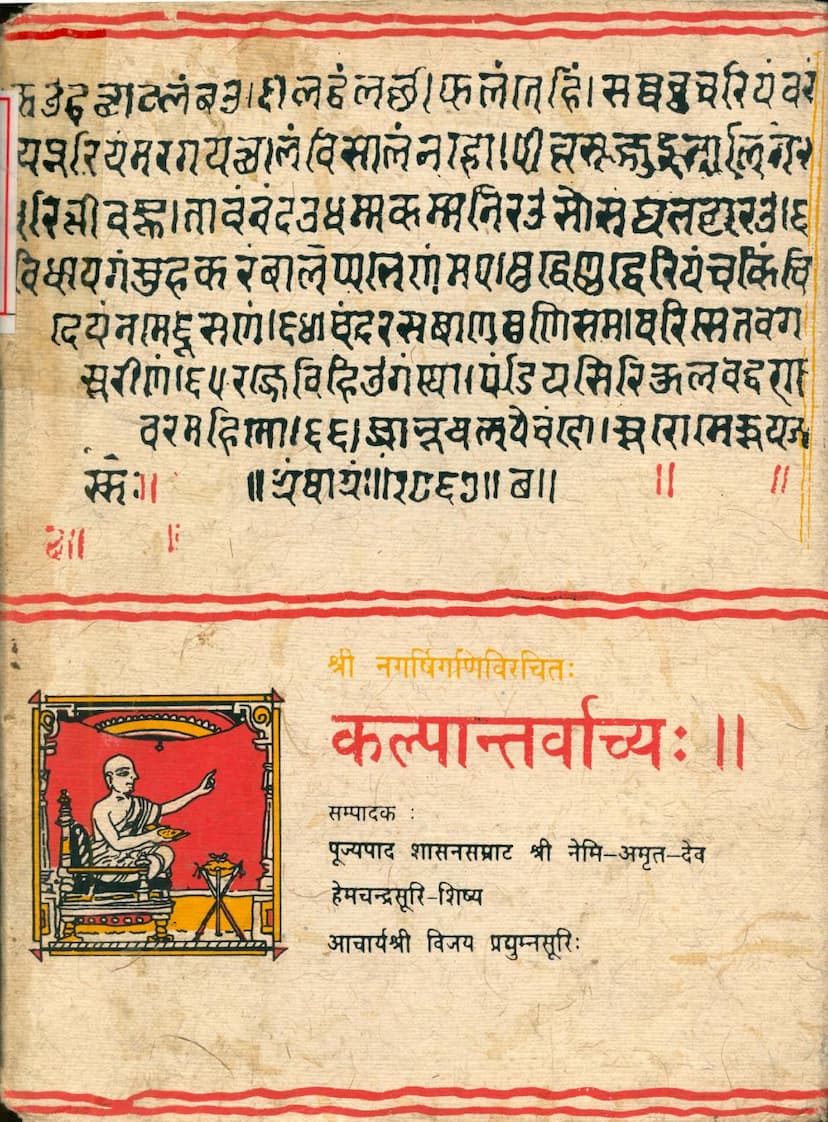Kalpantarvcahya
Added to library: September 2, 2025

Summary
Here's a comprehensive summary of the Jain text "Kalpantarvacya" by Pradyumnasuri, based on the provided pages:
Book Title: Kalpantarvacya Author: Nagharshi Gani (written in VS 1657 / CE 1500) Editor: Acharya Vijay Pradyumnasuri Publisher: Sharadaben Chimanbhai Educational Research Centre, Ahmedabad Publication Year: First Edition CE 1967 Language: Prakrit (with commentary and Gujarati notes)
Overall Purpose and Content:
"Kalpantarvacya" is a commentary (or an 'antarvacya' - internal explanation) on the Kalpa Sutra, a highly revered Jain text. The Kalpa Sutra is recited annually during the Paryushana festival and details the lives of Tirthankaras, the lineage of spiritual leaders (Sthaviravali), and the rules of conduct for monks and nuns (Shramanachar).
While the Kalpa Sutra itself is concise, often presenting information in a sutra-like style with hints and references, "Kalpantarvacya" serves to elaborate on these points, providing detailed explanations and clarifications. It aims to make the often-abbreviated or symbolic references within the Kalpa Sutra more accessible and understandable.
Key Features and Contributions:
-
Elaboration on Kalpa Sutra: The primary function of "Kalpantarvacya" is to explain the various concepts, stories, and rules mentioned in the Kalpa Sutra. It expands upon the brief mentions found in the original text, offering a richer understanding.
-
Prakrit Language and Poetic Style: The original text by Nagharshi Gani is composed in Prakrit, a classical Jain language. It is written in a poetic style (padyamayi). The editor, Acharya Vijay Pradyumnasuri, notes that the language and style are simple and easy to comprehend.
-
Historical and Comparative Value: The preface highlights the historical significance of the details found in the text. It is considered valuable for scholars studying Jain history and literature, especially for those conducting comparative studies of the narratives.
-
Editorial Efforts: Acharya Vijay Pradyumnasuri is credited with meticulously editing and researching the text. He sourced manuscripts from Jain knowledge repositories, specifically mentioning two manuscripts from the Patan Shri Hemchandrasuri Gyan Mandir. He notes potential imperfections in the manuscripts, suggesting they might be copies of the original author's work rather than the original autograph.
-
Discussion on Chandalini's Story: The editorial section (pages 5-7) delves into a specific narrative detail concerning Chandalini (Chandanbala) and Lord Mahavir. It discusses a discrepancy between the version presented in "Kalpantarvacya" (and later in Upadhyay Vinay Vijayji's "Subodhika Vritti") where Chandalini initially had no tears when Mahavir visited, and other ancient texts (like Avashyak Churni) where she is described as having tears. The editor speculates on the origin of this differing narrative and expresses a personal belief that Chandalini would have had tears in her eyes.
-
Value for Study and Devotion: The text is deemed useful for those pursuing spiritual self-improvement (Atmasadhaks), academic study, and scholarly research. It also provides insights into the dedicated study practices of ancient Jain monks (Shramanas).
-
Appendices: The book includes appendices containing the ancient Churni (commentary) on the Kalpa Sutra and explanations of subject-specific terms, as compiled by Muni Punya Vijayji.
-
Acknowledgement of Support: The publisher thanks those who contributed to the book's publication, including the Sharadaben Chimanbhai Educational Research Centre for undertaking the publication, Pandit Ramesh Hariy for transcription, Muni Rajhans Vijayji for manuscript comparison, Professor P.C. Shah for proofreading, and the administrators of the Patan Shri Hemchandrasuri Gyan Mandir.
Structure and Key Sections (Based on page numbers and recurring themes):
- Introduction/Praise (Page 10): Begins with invocations and an introductory verse.
- Description of the "Ten Kalpas" (Pages 10-13): This section appears to detail ten distinct categories or rules within the Kalpa Sutra, referred to as "Dashadhā Kalpaḥ." This is likely a core part of the commentary's explanation of the Kalpa Sutra's structure.
- Narratives and Exemplary Lives (Pages 13 onwards): The text seems to include several illustrative stories and biographies:
- Nagketu's Story (Pages 16-18): A narrative illustrating the efficacy of austerities (Ashtam Tapa).
- Meghkumar's Story (Pages 24-26): A story highlighting patience and understanding difficult circumstances.
- Stories related to the Four Kalpas (Pages 26 onwards): Mentions of "Ashcharyani" (Wonders) and specific events like the transference of Mahavir's embryo.
- Descriptions of Tirthankaras: Sections appear dedicated to the lives of Tirthankaras like Rishabhnath (Pages 31-33, 77-82), Parshvanath (Pages 33-34, 67-70), Neminath (Pages 34-35, 70-74), and Mahavir (Pages 20-53, 64-67). These descriptions likely focus on their birth, childhood, asceticism, omniscience, and sermons, elaborating on points in the Kalpa Sutra.
- Upasargas (Obstacles faced by ascetics): Various accounts of trials and tribulations faced by ascetics, particularly Lord Mahavir (Pages 26-28, 48-56).
- Gautama Swami's Story (Pages 53-55): The conversion and attainment of omniscience by Indra, the chief Ganadhara.
- Aspects of Jain Conduct: Discussions on aspects of conduct like "Samiti" (carefulness), "Gupti" (control), "Upasargas" (obstacles), and specific rituals or observances.
- Descriptions of Dreams and their Interpretations (Pages 18-19, 32-37): Sections on "Lakshanadhikar" (characteristics) and interpretations of dreams ("Supralaxanapathakah").
- Mention of Brahmana Texts (Pages 21-22): A reference to the study of Vedic texts by disciples.
- The End of Life/Nirvana (Pages 28, 56-57, 66-67): Accounts of the final liberation of Tirthankaras and Ganadharas.
- Paryushana Festival (Pages 4, 11-13, 65-66): The text consistently refers back to the significance of Paryushana and its associated observances.
- The "Churni" Commentary (Pages 105-108): This section provides an excerpt from a commentary on the Kalpa Sutra, likely the one mentioned in the appendices, explaining terms and concepts related to Paryushana.
In essence, "Kalpantarvacya" is a scholarly and devotional work that breathes life into the foundational text of Jain monasticism, the Kalpa Sutra, by providing detailed explanations, historical context, and illustrative narratives, making it a valuable resource for both understanding and practicing Jain principles.